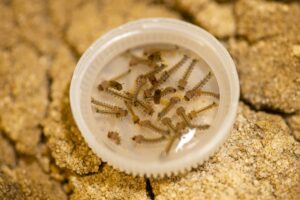Asian Tiger Mosquito
Quick Facts
- A black mosquito with white markings on head, body and legs.
- An agressive daytime biter.
- Rests in cool shady areas (like ivy).
- Lays eggs in containers.
- Capable of transmitting diseases.
- The amount of water held in a bottle cap or gum wrapper is
enough water for a mosquito to lay her eggs!
Photo by Lawrie Morello
 The Aedes albopictus mosquito, commonly known as the Asian tiger mosquito (ATM) was first found in Warren County, in Phillipsburg, on August 28, 2012. Warren County was the last county in New Jersey to find the ATM. They were first found in North America in Houston, Texas in 1985, arriving in the United States in a shipment of used tires from Japan. They made their way to Maryland and Delaware by 1987 and were first found in New Jersey in Monmouth County in 1995.
The Aedes albopictus mosquito, commonly known as the Asian tiger mosquito (ATM) was first found in Warren County, in Phillipsburg, on August 28, 2012. Warren County was the last county in New Jersey to find the ATM. They were first found in North America in Houston, Texas in 1985, arriving in the United States in a shipment of used tires from Japan. They made their way to Maryland and Delaware by 1987 and were first found in New Jersey in Monmouth County in 1995.
The Asian tiger mosquito is distinctive and easily identified. The mosquito is black with white stripes on its legs, back & head. The ATM is an aggressive daytime biter. As if approaching below our radar, it flies close to the ground and approaches without the distinctive “wing whine” of other mosquitoes. Since it flies close to the ground it tends to bite around the ankles first, then working its way up. The ATM is relentless in its mission to take a bloodmeal, if swatted away it will repeatedly return to complete its mission.
Noted as one of the world’s most invasive species, its habitat in the jungles of Asia included water filled tree holes and the hollowed insides of bamboo stalks, it has now adapted to its surroundings. It is found in the “urban jungles” of the United States. A noted container breeder, the Asian tiger mosquito will lay its eggs in any man-made container it finds, allowing for its rapid population growth and progression. When first introduced into an area the ATM may not be aggressive but the ATM will quickly establish itself in the area and once established will become a very aggressive biter. Any item that holds water extends an invitation for the mosquito to lay its eggs. Buckets, flower pots, toys, cemetery urns, roof gutters, bottle caps and even an empty potato chip bag are just samples of the never ending supply of items available to become mosquito habitats. The ATM will find the tiniest collection of water to lay its eggs- even the finger holes of an unused bowling ball will do. Asian Tiger mosquitoes lay their eggs on the sides of containers. The eggs need to dry out before they are ready to hatch, when the containers again fill with water, the eggs hatch and the life cycle begins.
Photo credit: San Diego County Mosquito Control
